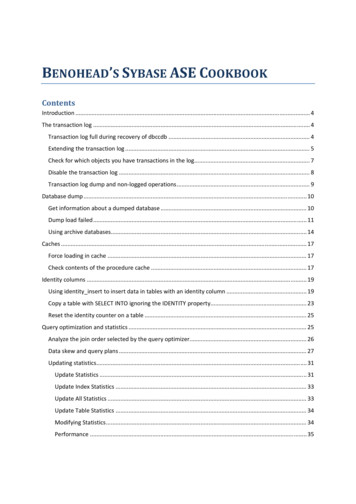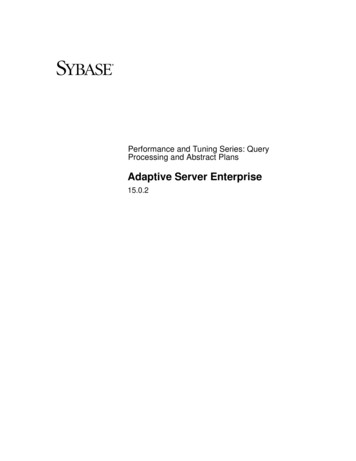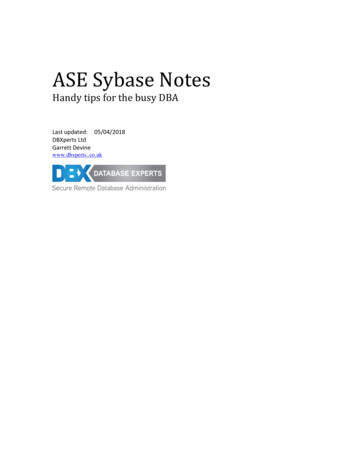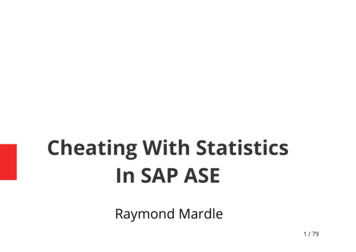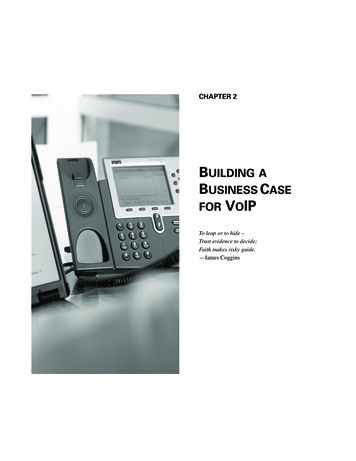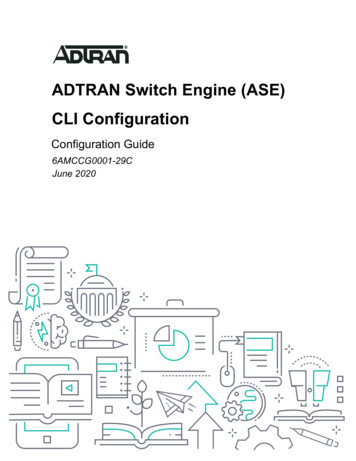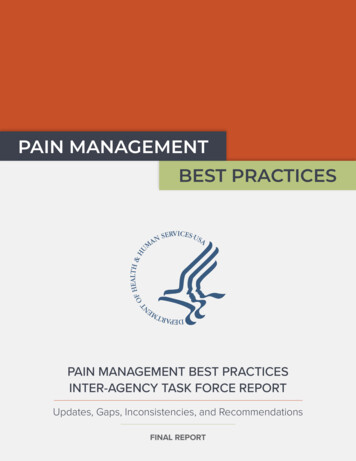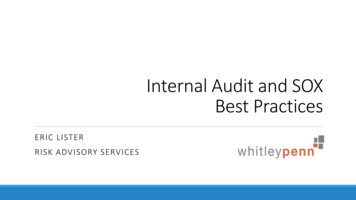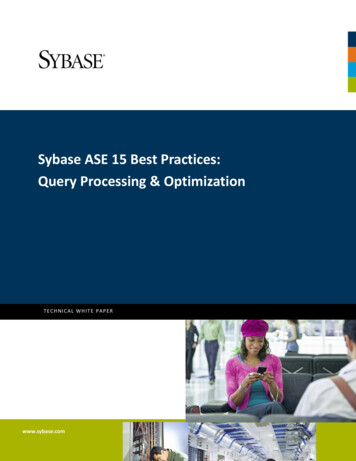
Transcription
Sybase ASE 15 Best Practices:Query Processing & OptimizationTECHNICAL WHITE PAPERwww.sybase.com
ContentsExecutive Summary . 3Historical Overview.3What's New with the ASE 15 Optimizer and Query Processing Engine . 4Understanding ASE 15's Query Processing . 5What is an optimization goal? . 5Optimization criteria .6Choosing the best optimization goal for your application . 6Experimenting with optimization goals . 7How to set session‐level optimization goals. 8Parallel query processing in ASE 15 . 8Performance monitoring tips .9Troubleshooting tips .9Using 'Compatibility Mode' in ASE 15.0.3 ESD#1 . 12If all else fails .12Obsolete optimization commands in ASE 15 . 13Resource Recommendations for ASE 15 . 14Procedure cache .14Procedure cache usage limitation in 15.0.2 ESD#2 . 14Other resource usage aspects of ASE 15 . 15Statistics In ASE 15 . 16Why statistics matter ‐ especially in ASE 15 . 16Recommendation: run update index statistics . 16Using 'sampling' with update index statistics . 16Speeding up update statistics with parallelism . 17When to run update statistics? . 17How many histogram steps? . 18Identifying missing statistics .20Old statistics and upgrading to ASE 15 . 20Summary of recommendations for statistics. 21Recommended Testing Before Upgrading To ASE 15 . 22Why should you test? .22Please note .23Using Compatibility Mode .23Identifying queries that run slower . 23Analyzing performance differences between ASE 12.x and ASE 15 . 23Analyzing short‐duration queries . 26Server‐level performance aspects . 26Example Of ASE 15 Query Plan And Lava Tree . 27ASE 15 Query Plans .27Example: set showplan .27Example: plancost and Lava Tree . 30Capturing Application SQL. 32Sybase ASE 15 Best Practices: Query Processing & OptimizationVersion 1.1 ‐ May 20091
Auditing .32MDA tables (12.5.0.3) .32Application Tracing (15.0.2) .33Abstract Plan Capture/Query Metrics Capture . 34Information To Capture Before Contacting Sybase TechSupport . 35701 Errors .35Performance Problem with a Limited Number of Queries . 36System‐Wide Performance Problems or High CPU Usage: step 1 . 37System‐Wide Performance Problems or High CPU Usage: step 2 . 38Uploading diagnostics to Sybase TechSupport through FTP . 39Conclusions And Recommendations . 40Reference Documents . 41Principal authorRob VerschoorContributing authorsSudipto ChowdhuriBill CoxMark KusmaNitin SadalgekarPeter ThawleyRaymundo TorresNingzhen ZhuRevision HistoryVersion 1.0Version 1.12February 2008May 2009First versionCover Compatibility Mode in 15.0.3 ESD#1; also, minor editing.Sybase ASE 15 Best Practices: Query Processing & OptimizationVersion 1.1 ‐ May 2009
Executive SummaryHistorical OverviewWhen Sybase first began to design its relational database management system in 1984, the world of InformationTechnology (IT) was radically different – applications were monolithic with data access code and business logictightly bound; transaction processing (OLTP) was predominately a batch process; and decision support (DSS)reporting never, ever, ran at the same time as transaction processing. Sybase's pioneering concept of client/servercomputing was based on two simple ideas. First, many businesses could offer better service and value to theircustomers if transaction processing were done "on‐line". Second, businesses could service their customers better,and therefore grow faster, by decentralizing application development and not using the mainframe. To enable thisradical approach, Sybase had to design and build a substantially different type of database kernel to support thisnew "on‐line enterprise".Sybase Adaptive Server Enterprise (i.e., the product formerly known as the Sybase SQL Server) became the leadingRDBMS product for high performance transaction processing supporting large numbers of client applicationconnections on relatively small, inexpensive hardware. To be successful in this demanding area, Sybase focusedheavily to optimize and streamline all the layers of our database engine for transaction processing workloads.While this focus turned out to be the asset that catapulted Sybase to a dominant position in high‐end OLTPapplications during the 1990's, it increasingly became a liability in some environments as application workloadshave changed and hardware performance has increased.With more and more enterprises requiring a mixture of both transaction processing and operational decisionsupport reporting on the same data at the same time, it became clear that Sybase needed to re‐architect its queryprocessing layer for the future. Sybase began the process in the 11.9.2 release when we re‐architected the"bottom half" of the query optimizer that dealt with the statistics and algorithms that drive query costing. Wethen embarked upon a significant effort to replace the top half of the optimizer and the query execution layer withone that could meet the next generation of application requirements. Equally important, we needed it to be moreextensible so that in the future, we could add support for new index types or new join strategies to more quicklyrespond to the needs of our customers. With ASE 15, Sybase has delivered this.With this historical context in mind, it is important for customers and partners who are looking to leverage themany benefits of ASE 15.0.x understand the significance of these changes. A good analogy for how to approachthis effort is just like breaking in the engine on your new car. Should you wind up the engine's RPMs to that redline and cruise your favorite winding back road at 100mph? As much as some of us would like to say yes, I suspectmost of us know the right answer. Well, using the new ASE 15 query optimizer and query execution is similar – goslower than you (or your boss) wants, learn the important characteristics of the system, and know what to do incase the red light comes on. This document is meant to help you with these last two!Sybase ASE 15 Best Practices: Query Processing & OptimizationVersion 1.1 ‐ May 20093
What's New with the ASE 15 Optimizer and Query Processing EngineThe first and most important thing to know about ASE 15's query optimizer and query execution engine is that it'sbasically totally new. The shift in requirements over the years towards mixed workloads (i.e., concurrent OLTP andDSS application profiles) stretched our traditional relational processing methods of "nested loop" joins to theirbreaking point. If you consider the fact that it is now common to see queries joining ten's of tables with manycomplex search arguments and/or aggregation, it was clear that both the query optimizer and the query executionengine needed a major overhaul. More importantly, we needed to design a solution to ensure both the optimizerand execution engine would be extensible. This allows us to add new and innovative algorithms (for joining,grouping, union, etc) and storage structures (e.g. index types) more easily without kludging existing code andmaking it unmanageable or error‐prone. To facilitate the modularity and extensibility of the query executionengine, we have rebuilt the execution engine using a more modern, consumer‐driven, iterator‐based executionmodel. This model implements relational operators as primitive building blocks and provides both the ability toeasily solve nagging limitations as well as add important new join strategies and optimizations. Before we get intothe details of how to use and troubleshoot the new optimizer and query processing engine, let's first gain anunderstanding of the major changes which affect both applications and operations.Long‐time ASE customers will appreciate the elimination of limitations which all of us have suffered through. Overthe years, Sybase has steadily been reducing the occurrences when data type mismatches would prevent apredicate from being considered during optimization. Unfortunately, our efforts were "hardwired" so we had toadd special case code for eac
Sybase began the process in the 11.9.2 release when we re‐architected the "bottom half" of the query optimizer that dealt with the statistics and algorithms that drive query costing.
